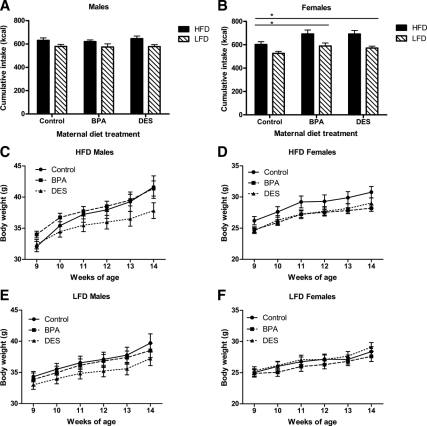Figure 5.
Growth on HFD vs. LFD from 9–14 wk of age. Cumulative caloric intake was increased in male and female mice eating a HFD vs. LFD. A, Among males, there was no effect of maternal treatment on caloric intake [ANCOVA: P (diet) <0.001, P (maternal treatment) >0.05, P (litter size) >0.05]. B, Among females, control mice ate fewer calories compared with either BPA or DES mice [ANCOVA followed by Tukey post hoc tests: P (diet) <0.0001, P (maternal treatment) <0.01, P (control vs. BPA) <0.05, P (control vs. DES) <0.05, P (litter size) <0.05]. Male mice gained more weight while eating a HFD (C) vs. LFD (E). DES males tended to be lighter than either control or BPA males, although this difference did not reach statistical significance [repeated-measures (RM) ANCOVA followed by Tukey post hoc tests: P (maternal treatment) <0.05, P (diet × time) <0.000001, P (maternal treatment × time) <0.0001, P (DES vs. control) <0.058, P (DES vs. BPA) <0.058, P (litter size) >0.05]. Female mice gained more weight while eating a HFD (D) vs. LFD (F). There were no differences in body weight among the groups [RM ANCOVA: P (maternal treatment) >0.05, P (diet × time) <0.001, P (litter size) <0.05, P (litter size × time) <0.05]. *, P < 0.05.

